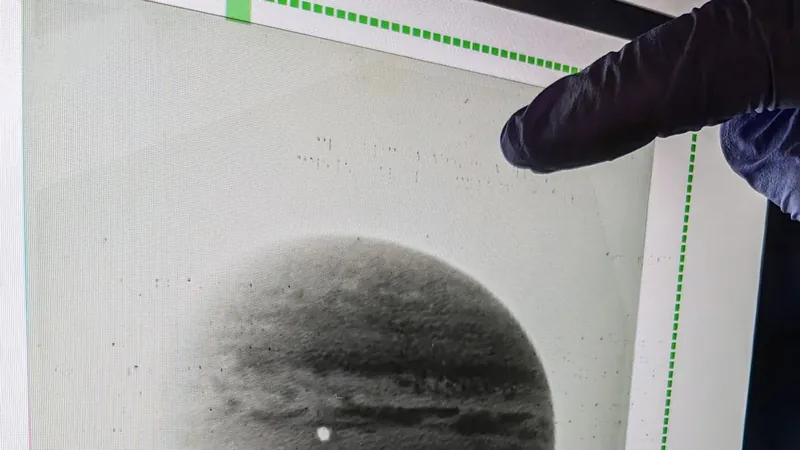
The Unsung Heroes of NASA: How Archivists Are Resurrecting Our Cosmic Past
2024-11-24
Author: Wei
The Unsung Heroes of NASA
In an era where space exploration continues to break new ground, a dedicated team at NASA is digging through decades of forgotten data, breathing new life into the treasures of astronomical history. The scientists at NASA's Space Science Data Coordinated Archive (NSSDCA) are meticulously restoring invaluable data from past missions, which not only helps us understand our cosmic history but also paves the way for future explorations.
According to David Williams, a planetary scientist at the NSSDCA, a significant amount of historical information has either deteriorated or simply been lost. "We have an extensive collection of photographs, reels of film, microfilm, and microfiche from various missions," Williams shared. "We're making slow but steady progress in recuperating these materials."
The Importance of Archivists
The work of these archivists is paramount. The recovered data not only serves academic purposes but plays a vital role in shaping future missions. One key example is the upcoming DAVINCI (Deep Atmosphere Venus Investigation of Noble gases, Chemistry, and Imaging) mission set to launch in the early 2030s, which aims to unveil the mysteries of Venus. By utilizing modern analytical techniques on data from missions as far back as the 1990s, like NASA's Magellan mission, scientists are now better equipped to explore unique geological features like Alpha Regio, a vast plateau on Venus that might hold clues to the planet's volcanic past.
Meet the Archivists
None of this could be possible without the relentless efforts of the NSSDCA team. Under Williams’ leadership, the team works not only as archivists but also as detectives to search for missing data. Their task has become increasingly complex, especially considering that prior to the late 1980s, there were virtually no standard procedures for archiving space mission data. The NSSDCA has since implemented robust protocols that ensure data from missions is well documented and preserved.
Williams expressed his passion for this detective work: "There's an element of excitement in digging up hidden data and deciphering its meaning for future astronomers."
The Haunted Past of Data Loss
Despite modern procedures, there is still a considerable amount of data from earlier missions that has gone missing or is poorly documented. In some instances, such as the legendary Viking landers from 1976—which sought to find signs of life on Mars—Tim Williams and his team discovered shocking gaps in documentation that made retrieving lost data a Herculean task. "Documentation is just as crucial as the data itself," he acknowledged. "Without it, we’re left guessing what the data signifies."
One of the more bizarre instances of lost data stems from the Apollo missions, specifically the Apollo Lunar Surface Experiment Packages (ALSEP). These science stations provided key measurements on the lunar surface, but many invaluable data tapes were lost due to unforeseen circumstances involving data storage practices.
Current State of Data Management: The Iron Mountain Approach
Fortunately, today’s data practices have evolved dramatically. Most of NASA's data is now stored digitally, backed up in secure locations like the famed "Iron Mountain," a storage facility designed for long-term preservation. Williams reassured that as all new data is digitized and archived, the chances of losing crucial data have diminished significantly, though vigilance is essential as technological advancements pose new challenges.
"We're working to future-proof these archives," Williams noted, addressing the shift in formats and software that could render older data unreadable. The NSSDCA uses simple formats like ASCII tables to ensure usability, regardless of what technologies might change in the next century.
Conclusion
As the NSSDCA continues to recover and digitize aging data, they uncover new insights that could lead to groundbreaking discoveries. Each fragment of data unearthed spills secrets of our celestial history right into contemporary research, inviting the world to unravel the mysteries of the cosmos.
With the ongoing commitment of people like David Williams and their dedicated team, our understanding of space continues to grow. They not only preserve our past but also remind us that the study of our universe is an ever-evolving narrative—one that may still have yet unfound treasures hiding in its folds, just waiting for curious minds to explore.




 Brasil (PT)
Brasil (PT)
 Canada (EN)
Canada (EN)
 Chile (ES)
Chile (ES)
 España (ES)
España (ES)
 France (FR)
France (FR)
 Hong Kong (EN)
Hong Kong (EN)
 Italia (IT)
Italia (IT)
 日本 (JA)
日本 (JA)
 Magyarország (HU)
Magyarország (HU)
 Norge (NO)
Norge (NO)
 Polska (PL)
Polska (PL)
 Schweiz (DE)
Schweiz (DE)
 Singapore (EN)
Singapore (EN)
 Sverige (SV)
Sverige (SV)
 Suomi (FI)
Suomi (FI)
 Türkiye (TR)
Türkiye (TR)